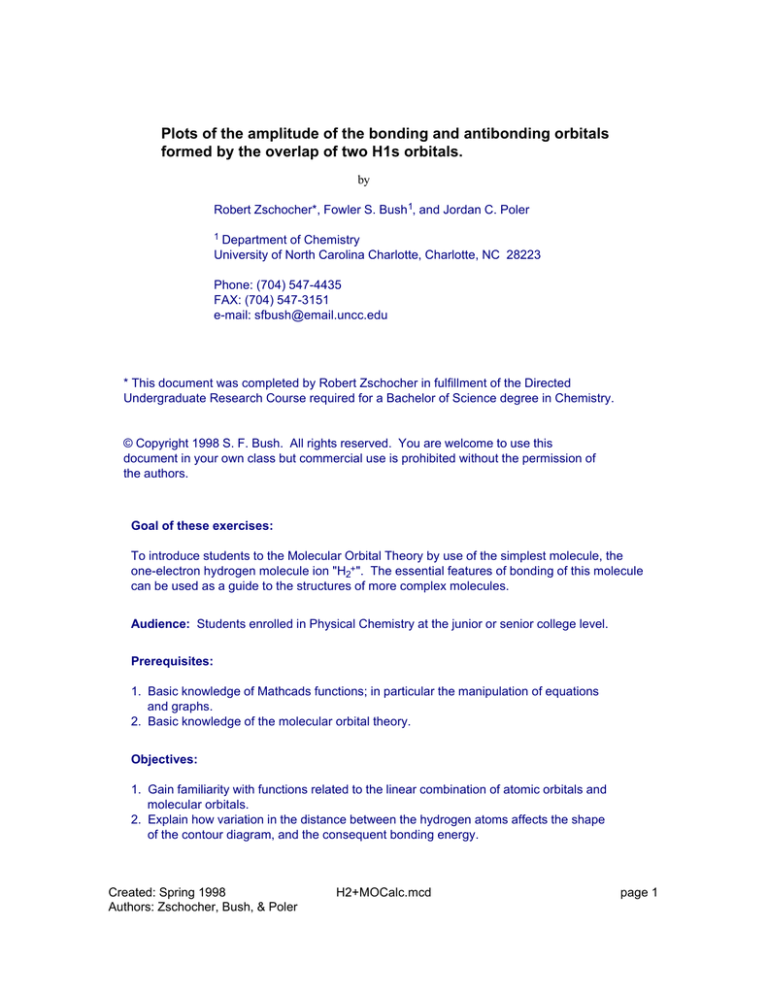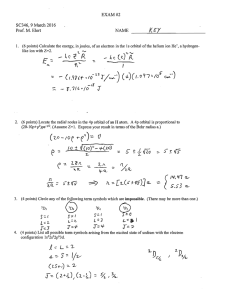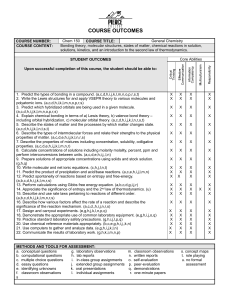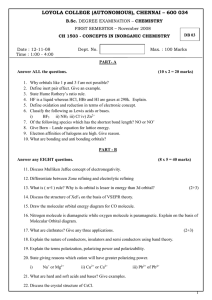
Plots of the amplitude of the bonding and antibonding orbitals
formed by the overlap of two H1s orbitals.
by
Robert Zschocher*, Fowler S. Bush1, and Jordan C. Poler
1
Department of Chemistry
University of North Carolina Charlotte, Charlotte, NC 28223
Phone: (704) 547-4435
FAX: (704) 547-3151
e-mail: sfbush@email.uncc.edu
* This document was completed by Robert Zschocher in fulfillment of the Directed
Undergraduate Research Course required for a Bachelor of Science degree in Chemistry.
© Copyright 1998 S. F. Bush. All rights reserved. You are welcome to use this
document in your own class but commercial use is prohibited without the permission of
the authors.
Goal of these exercises:
To introduce students to the Molecular Orbital Theory by use of the simplest molecule, the
one-electron hydrogen molecule ion "H2+". The essential features of bonding of this molecule
can be used as a guide to the structures of more complex molecules.
Audience: Students enrolled in Physical Chemistry at the junior or senior college level.
Prerequisites:
1. Basic knowledge of Mathcads functions; in particular the manipulation of equations
and graphs.
2. Basic knowledge of the molecular orbital theory.
Objectives:
1. Gain familiarity with functions related to the linear combination of atomic orbitals and
molecular orbitals.
2. Explain how variation in the distance between the hydrogen atoms affects the shape
of the contour diagram, and the consequent bonding energy.
Created: Spring 1998
Authors: Zschocher, Bush, & Poler
H2+MOCalc.mcd
page 1
References:
1. Barrow, Gordon M. Physical Chemistry; 5th ed. New York: McGraw-Hill, (1988).
2. Atkins, P.W. Physical Chemistry; 5th ed. New York: W.H. Freeman and Company, (1994).
3. Karplus, Martin, and Porter, Richard N. Atoms & Molecules: An Introduction for Students of
Physical Chemistry. New York: W.A. Benjamin, Inc., (1970).
Note: The use of units was avoided due to the complexities of Mathcad. All dimensions are
related to picometers.
I. The trial molecular orbital wavefunction.
Figure 1 suggest that to construct a molecular orbital we should use the atomic 1s-orbital
wavefunctions for both hydrogen atom A and hydrogen atom B. As the figure also suggest, we will
define rA and r B as the dstances of the single electron from atoms (protons) A and B. Rather than
designating the wavefunction as Ψ 1s(A) we have just used 1SA .
Therefore a good trial wavefunction for the bonding MO is Ψb = 1/2(1SA + 1sB ) and for the
antibonding MO, Ψa = 1/2(1SA - 1S B ). However we must first normalize these functions
to insure that they will behave properly.
II. Normalization of φ at the limit of rAB = ∞.
1. S A
1 . 1
a
π 0
3
2
.e
r
A
a
0
1. S B
1 . 1
a
π 0
3
2
.e
r
B
a
0
a0
52.9 picometers
With the atomic orbitals defined above we take the all-space integral of the bonding MO
and set equal to 1 to normalize. N is the normalization constant.
Created: Spring 1998
Authors: Zschocher, Bush, & Poler
H2+MOCalc.mcd
page 2
2
2
N .
Ψb dr
We use the symbolic "=" for these equations because
we are not asking Mathcad to perform any computations.We
are merely making declarations.
1
Ψb dr
2
1. S A
2
1 . SA
Ψb dr
1 . SB
2
2
dτ
1 . SB
dτ
2
1 . SA. 1 . SB dτ
dτ
The third term on the right above is the terrifying overlap integral, S. In the limit as R approches
infinity, there is no overlap so S is zero. Since the 1s atomic orbitals were normalized, the first
two terms of the above equations are just one (1). Therefore,
2
Ψb dr 1
1
0
and N2 = 1/2.
Ψb
The normalized bonding MO is:
1 . .
1 SA
2
1. SB
Next, normalize Ψa for the negative linear combination (antibonding MO) to get:
Ψa
1 . .
1 SA
2
1 . SB
At this point it is easy to determine that the normalization constants for the respective
MOs at distances where overlap will occur are:
N 1 ( bonding )
1
2
1
2. ( 1
Created: Spring 1998
Authors: Zschocher, Bush, & Poler
S)
and
N 2 ( antibonding )
H2+MOCalc.mcd
1
2
1
2.( 1
S)
page 3
III. Plot the amplitude function.
Plot of the amplitude function for H2+: As a function of position along the x-axis, Atom-A is at zero and
atom-B is at 106 pm. The index "i" runs 0 to 400 but in order to get negative values to plot on the x-axis,
we used an offset of 253 (200 plus half of the bond distance) so that the zero point of the plot is midway
between the atomic centers.
Bonding Molecular Orbital
i
S
1
ψA
i
2
R
1. R
a0
3 a0
1
2
1
i
.e
3
π. a 0
0 .. 400
.e
R
a0
a0
52.9
R
(The overlap integral
N1
see ref. 1)
253
a0
ψB
ψi
106
N 1. ψ A
i
ψB
1
i
1
.
2 ( 1 S)
1
2
(i
The normalization
constant
R)
i
1 10 6
0.001
ψi 5 10 4
0
253
a0
.e
3
π. a 0
1
2
ψi
200
0
i
200
2
5 10
7
0
200
200
0
i
200
200
What area of the graph relates to the integration over {ψ1s(A)}2?; {ψ1s(B)}2?
What area of the graph relates to the overlap integral (S), 2ψ1s(A)ψ1s(B)?
The overlap density represents the probability of finding an electron in the internuclear region
above what it would be if it were confined to one of the atoms. The electron is free to move from
one nucleus to the other.
How does the probability of finding an electron between the nuclei change at various values of R?
Created: Spring 1998
Authors: Zschocher, Bush, & Poler
H2+MOCalc.mcd
page 4
Manipulate the graphs below by changing the value of R.
1
2
R
R
106
1
2
1
ψA
i
1
R
1. R
a0
3 a0
253
a0
.e
3
π. a 0
i
S
ψB
1
i
3
π. a 0
2
.e
1
2
(i
.e
a0
253
a0
2. ( 1
S)
R)
ψi
N 1. ψ A
i
ψB
i
1 10 6
0.001
ψi 5 10 4
0
1
N1
ψi
200
0
i
2
5 10
7
0
200
200
0
200
i
200
200
Antibonding Molecular Orbital
S
1
ψA
i
R
1. R
a0
3 a0
1
3
π. a 0
1
2
i
.e
i
0 .. 400
2
R
a0
.e
a0
52.9
R
1
.
2 ( 1 S)
N2
253
a0
ψB
ψi
Created: Spring 1998
Authors: Zschocher, Bush, & Poler
N 2. ψ A
i
1
3
π. a 0
i
ψB
106
1
2
1
2
(i
.e
253
a0
R)
i
H2+MOCalc.mcd
page 5
2 10 6
0.002
ψi
ψi
0
0.002
0
200
2
1 10
6
0
400
0
200
i
400
i
Does the energy of the σ1s∗ orbital increase or decrease as R decreases from large values?
How does the probability of finding an electron between the nuclei change at various values of R?
Manipulate the graphs below by changing the value of R.
R
S
ψA
i
1
1
R
1. R
a0
3 a0
1
2
i
.e
3
π. a 0
2
.e
a0
1
N2
2. ( 1
a0
ψB
N 2. ψ A
i
1
3
π. a 0
i
ψB
(i
.e
253
a0
R)
i
2 10 6
0.002
ψi
0
0.002
S)
1
2
253
ψi
ψi
1
2
R
106
0
200
400
i
Created: Spring 1998
Authors: Zschocher, Bush, & Poler
2
1 10
6
0
0
200
400
i
H2+MOCalc.mcd
page 6
Three dimensional plots of the amplitude functions:
1.
R
a0
3
a0
12
pm S 10 1 . m
2 . FRAME
R
n
1
a 0. ( i
rA
i,j
i,j
a0
j
5
R
2. ( 1
i,j
100
1
2 2
rB
3
π. a 0
1
2
.e
rA
i,j
a0
4 10
a 0. ( i
i,j
1 .. 20
ψ 1sB
i, j
3
π. a 0
10 )
2
j
15
R
100
1
2 2
50
rB
1
2
1
.e
i,j
a0
Antibonding Molecular Orbital
ψ 1sB
Ψa
i,j
i,j
N . ψ 1sA
i,j
8 10 4
6 10
j
S)
Bonding Molecular Orbital
Ψb
1 .. 20
1
2
10
N . ψ 1sA
i,j
i
52.9
1
N
1
2
1
ψ 1sA
.e
100
Z
10 )
R
a0
2
R
ψ 1sB
i, j
N
1
.
2 ( 1 S)
1
2
5 10 4
4
0
4
2 10 4
5 10
0
5
10
15
0
4
20
0
5
10
15
20
Ψb
Created: Spring 1998
Authors: Zschocher, Bush, & Poler
Ψa
H2+MOCalc.mcd
page 7
III. Calculation of the Bonding Energy
a0
ρ
5.29177 . 10
11
0.1 , 0.2 .. 10
r
2.30711 . 10
Ν
6.023. 10
28
e
23
4
2
π
ε0
repulsion r
The Vaa term represents an integral that gives an energy contribution that is negative and its value
depends on the coulombic attraction between an electron in the atomic orbital centered on A and
the positive charge of nucleus A.
The Vab term also represents an integral that gives an energy contribution that is negative and its
value depends on the coulombic attraction between the postive charge of one nucleus and the
electron distribution that is based on both the 1Sa and 1Sb atomic orbitals.
See reference 1 for further information concerning the terms Vaa and Vab.
S( ρ)
Vaa( ρ)
ρ
e . 1
Ν.r . 1
a0
ρ
2
ρ
e
ρ
repulsion( ρ)
3
2. ρ .
Ν.r
ρ. a
0
1
1
ρ
Created: Spring 1998
Authors: Zschocher, Bush, & Poler
Vab( ρ)
Ν.r .
ρ
e .( 1
a0
H2+MOCalc.mcd
ρ)
page 8
Bonding Orbital
Vaa( ρ)
binding( ρ)
sum( ρ)
1
repulsion( ρ)
Antibonding Orbitals
Vab( ρ)
antibinding( ρ)
S( ρ)
binding( ρ)
antisum( ρ)
binding( ρ )
1
repulsion( ρ)
3 107
3 107
7
2 10
7
2 10
repulsion( ρ )
Vaa( ρ)
Vab( ρ)
S( ρ)
antibinding( ρ)
repulsion( ρ )
7
1 10
7
antibinding( ρ ) 1 10
sum( ρ )
antisum( ρ )
0
1 107
0
0
1 107
5
ρ
0
5
ρ
The following graph is focused on the sum of the binding and repulsion energies in the negative
region of the binding energy "dip". The sum of the antibinding and repulsion has also been
included.
5
4 10
sum( ρ )
5
2 10
antisum( ρ )
0
0
2 105
2
4
6
8
ρ
Created: Spring 1998
Authors: Zschocher, Bush, & Poler
H2+MOCalc.mcd
page 9
Does the energy of the σ1s orbital increase or decrease as R (the distance between nuclei)
decreases from large values?
At very small values of R what happens to the energy of the σ1s orbital?
Which expression of ψ is higher in energy the bonding or antibonding?
The Vaa term is negative lowering the energy. The Vab term is also negative but occurs with a
minus sign. How does this affect the stability of the molecule ion?
Created: Spring 1998
Authors: Zschocher, Bush, & Poler
H2+MOCalc.mcd
page 10




